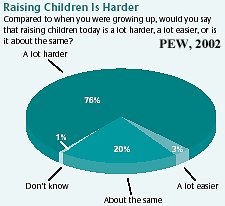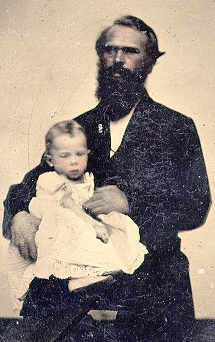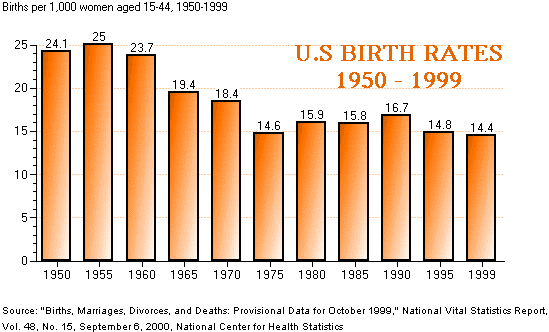TO HAVE OR NOT TO HAVE?
In the 1970s, roughly 50,000 parents responded to a query by advice columnist Ann Landers, who asked whether, if given the choice again, they would have children. Seventy percent said no, that it wasn't worth it. Was this depressing feedback a function of the times? biased in terms of who reads Ann Landers? or was it possibly the result of only unhappy parents taking the time and energy to respond? Are the sociobiologists correct in claiming that creatures must be tricked into assuming the incredible energies required to raise the next generation?
As the family transformed from being a unit of production to being a unit of consumption, children were no longer to be viewed as economic assets but rather as liabilities. With this historic change, coupled with the commodification of so many aspects of family life, it should come as no surprise that a price tag has been affixed to the cost of having children. According to the U.S. Department of Agriculture--yes, the same folks who tell you about breeding poultry, rabbits, and livestock--the cost of raising through the age of seventeen (college bills are an "optional") a child born in 1996 will be $149,820 ($160,140 for one born in 1999)--or just about one million dollars for the McCaugheys, the Iowa parents of septuplets. In 1960, when the folks at Washington first made such calculations, the tab was $25,229. Click here for the 1995-2005 annual reports, "Expenditures on Children by Families" (pdf file format).
Suffering from sticker shock? When framing parenting as some expensive hobby--all for someone who doesn't write home when an adult--it would seem most rational economically to raise cats or dogs. As far as I know, the government does not compute the returns on this investment. Some, however, do. In the state of Texas in legal cases involving the negligent death of an adult child, the parents can sue the guilty party for the value of the "kindness and attention" that their deceased child would have given them for the remainder of their lives.
In NORC's 1994 General Social Survey, Americans were asked "People
who never had children lead empty lives--do you agree or disagree?"
Below are the responses:
| RESPONSE | % | CUM % |
| STRONGLY AGREE | 3.5% | 3.5% |
| AGREE | 15.8% | 19.4% |
| NEITHER | 27.6% | 46.9% |
| DISAGREE | 39.6% | 86.5% |
| STRONGLY DISAGREE | 13.5% | 100% |
| TOTAL | 1,353 |
Speaking of a variable that invites certain controls! What difference does actually being a parent make? How did the sexes vary in their responses? How do answers vary across the life-cycle?
PERCENT DISAGREEING CHILDLESS PEOPLE LIVE EMPTY LIVES
| PARENT | NO KIDS | TOTAL | |
| MALES | 46% | 71% | 48% |
| FEMALES | 50% | 78% | 56% |
| TOTAL | 46% | 71% | 53% |
- Click here for fertility rates of American women 1810-
- Click here for inquiries into the relative marital satisfactions of childless couples and parents.
STRUCTURES OF FAMILIES WITH CHILDREN
 According to the Urban Institute's 1997
National Survey of American Families, 63 percent of children live in two-parent, 27
percent in one-parent, and 8 percent in blended families.
According to the Urban Institute's 1997
National Survey of American Families, 63 percent of children live in two-parent, 27
percent in one-parent, and 8 percent in blended families.
The Duke of Windsor noted "The thing that impresses me most about America
is the way parents obey their children." Since the second world war,
many have observed the rise of child-centered, as opposed to adult-centered,
families in the United States. Associated with this trend are such
phenomena as the erosion of authority and the proliferation of adults who
have never had to "grow up."
THINKING ABOUT SOCIALIZATION
 In 2002, Public Agenda released its "A
Lot Easier Said Than Done: Parents Talk About Raising Children in Today's
America" survey. Among the findings:
In 2002, Public Agenda released its "A
Lot Easier Said Than Done: Parents Talk About Raising Children in Today's
America" survey. Among the findings:
- a large majority of parents say American society is an inhospitable climate for raising children
- nearly half the parents said they worry more about protecting their child from negative social influences than they do about paying the bills or having enough family time together
- 6 in 10 rate other parents only "fair" or "poor" in raising their children
Typically, socialization studies examine the effects of parenting on children. But socialization is a two-way street, evidenced by the IQ drops of mothers with young children. Click here to see the impact of having children on the political views of women and men by educational level.
Click here for childcare arrangements of working mothers, 1977-93.
Click here for further inquiries into the socialization process.
WHEN WILL THEY EVER LEAVE?
One much discussed demographic trend is how more young adults are staying with their parents. By 1990, for instance, one in three single American men between the ages of 25 and 34 was living with one or both parents (Click here to see the percent of 25-34-year-old males and females living at home from 1960 to 1995). Some attribute the phenomenon to the high cost of living. Others argue that with modernity's increases of life-expectancy and social complexity there has been a concomitant prolongation of adolescence and dependency. See Billie Frazier's annotated bibliography on the subject.
![]()
FOCUSING ON THE PARENTS
One of the most far-reaching changes in [moral] norms relates to what parents believe they owe their children and what their children owe them. ...The overall pattern is clear: today's parents expect to make fewer sacrifices for their children than in the past, but they also demand less from their offspring in the form of future obligations than their parents demanded of them....Sixty-seven percent believe that "children do not have an obligation to their parents regardless of what their parents have done for them."
--Daniel Yankelovich, New Rules: Searching for Self-fulfillment in a World Turned Upside Down, 1981:102
THE FATHER ROLE
By the time a man realizes that maybe his father was right,
he usually has a son who thinks he's wrong.
--Charles Wadsworth
Percentage of Americans who say their best friend is their
father: 0.
Rank of Father's Day among days on which the largest number of collect
calls are made: 1.
--Harper's Magazine. "Harper's
Index." (Sept. 1991, June 1994).

There is a story of Boswell, the famous biographer of Samuel Johnson. In his advanced years, Boswell reflected on the most important day of his life. He said it occurred one day during his youth, when his father had invited him to go fishing. While most of his childhood days had long since been forgotten, during that one day Boswell said that he learned about what life was about through example. Some industrious historian decided to track down the diary of Boswell's father to see how he reflected on that most important day in the life of his famous son. The entry: "Went fishing today with my son. A whole day wasted."
In many ways 1993 was the Year of the Father, evidenced by the massive media attention to the role around Father's Day. The father role was featured as cover stories of weekly news magazines. In October of 1993, Houston Oilers docked David Williams (a five-year starter who made $2 million a year) $125,000 for failing to play in a game against the New England Patriots because he stayed with his wife for the birth of their first child. Two years later, President Clinton directed all Federal agencies to review their programs with the goal of strengthening the father role. Click here to see the response of the Department of Health and Human Services: "Fathering: The Man and the Family."
For an interesting story, read the case history of Morgan Wise, a man who discovered that three of his four children were not his and how, after divorcing his wife of 13 years, still is forced by the courts to make child support payments.
The amount of waking time 4-year-old children spend alone with their fathers each day compared with daily waking time in day care, according to a 1986-94 study by the Netherlands-based International Association for the Evaluation of Educational Achievement.
|
COUNTRY |
TIME WITH DAD | TIME IN DAYCARE |
|---|---|---|
| Belgium | 30 minutes | 6.8 hours |
| China | 54 minutes | 11 hours |
| Finland | 48 minutes | 6.8 hours |
| Germany | 36 minutes | 5 hours |
| Nigeria | 42 minutes | 7 hours |
| Portugal | 24 minutes | 8.8 hours |
| Spain | 18 minutes | 7 hours |
| Thailand | 12 minutes | 11 hours |
| United States | 42 minutes | 5.6 hours |
Elsewhere, we found that, when Americans were asked to rate the roles different adults played in the lives of children, fathers came in a poor third--behind mothers and grandparents--scoring roughly in the midpoint between the mean scores given to mothers and to clergy, ministers, and rabbis.
How has dad become such a peripheral guy that the government now has to track down his "deadbeat" contingent? Why do only three out of five American children live with their biological fathers? Historians inform us that in colonial America it was the father who was the primary socializer, particularly of young males. Carl Degler, for instance, observes how, until the early 1800's, child-rearing manuals were not even addressed to mothers. In these patriarchal times, the old man was, indeed, "king of his castle." His children were his property (when they said that's "Joe's son," the statement was referring to this property status and not a genetic connection). In the rare instances of divorce, his custody of them was rarely challenged.
- With industrialization and the bifurcation of public and private life, dads' primary (and socially approved) activities were in the public realm of work while the sphere of mothers' control was in the private realm of family life (referred to as the "feminization of the domestic sphere"). Adequacy of one's performance of his father role was largely judged on the basis of his "breadwinner" activities. In 1900, one observer noted how "the suburban husband and father" had become "almost entirely a Sunday institution." To this day, corporate America advises the new father not to take paternity leave if he is to be "taken seriously."
- The role of "father" is dialectically related to roles of "mother"--which has changed dramatically over the post-war years, dissolving the males' distinctive (and authority- enhancing) role as primary wage earner --and "children"-- whose status in the family historically shifted from being economic assets to economic liabilities as the family transformed from being a unit of production to being a unit of consumption.
- Over the postwar era, as families have become increasingly leisure- and child- oriented (at least within the middle-class), instead of serving as a role model in dealing with the public realm, fathers now often sit on the sidelines to view their children's performances in sports and in the arts.
There are, however, signs of change:
- nowadays, more than 90 percent of fathers are present in the delivery room, compared to almost none thirty years earlier.
- according to a 1993 report issued by the Population Reference Bureau (authored by Martin O'Connell of the Census Bureau), fathers are the primary care givers for one in five preschoolers whose mothers work.
- there is a growing market for fathering "self-help" books and websites, with such titles as How to Father, Expectant Father, Pregnant Fathers, The Birth of a Father, Fathers Almanac, Father Power, and How to Father a Successful Daughter>
Implications of Fatherlessness
A community that allows a large number of young men to grow up in broken families, dominated by women, never acquiring any stable relationship to male authority, never acquiring any set of rational expectations about the future--that community asks for and gets chaos.
--Patrick Moynihan, 1965
What are the consequences of 37% of America's children sleeping in homes where their natural fathers don't live? Department of Health and Human Services Secretary Louis Sullivan observed in 1994 that "Children who do not live with a mother and father are more likely to be high school dropouts, more likely to abuse drugs and alcohol and more likely to be dependent on welfare than children who live with both biological parents." By the mid-1990s, 46% of families with children headed by single mothers were living below the poverty line, compared with 8% of children living with two parents.
Elsewhere we examined the overall effects of divorce on children, but what are the direct consequences of not having a father? Mothers and fathers are complementary and not interchangeable roles. Fathers are not substitute mothers. Among the speculations and findings:
- absence of role modeling for young males;
- higher risks for males of having low esteem and being emotionally rigid;
- in Nancy Gibbs Time magazine cover story "Bringing Up Father"
(June 28, 1993:52- 61), it was reported how some researchers find mothers'
love to be unconditional while that of fathers is more qualified and tied
to performance, and how mothers are more likely to be worried about their
children's survival while fathers are more likely to be concerned about
their future success.
- Yahoo's directory of Fathering sites
- Nurturing Fatherhood: Improving Data and Research on Male Fertility, Family Formation and Fatherhood
- The World Wide Web Virtual Library: Fatherhood and Fatherlessness
- National Center for Fathering
- Joseph Peck's "Balancing Work and Family: Fathers who live with their families are spending more time with their children. At the same time, more fathers are not living with their families" Scientific American, June 1999
- National Fatherhood Initiative
- National Fathers Network
- American Coalition for Fathers and Children
- Fatherhood: The Parent Role (U. Akron School of Family & Consumer Sciences)
- Yahoo! - Society and Culture:Holidays:Fathers Day
- FatherWork:Stories & Ideas to Encourage Generative Fathering
- Full-Time Dads Home Page
- At-Home Dad-- a quarterly newsletter
THE MOTHER ROLE
Every mother is a judge who sentences her children for the
sins of the father.
--Rebecca West

After a touchdown is made and the camera focuses on the scorer, what is it the football player says to millions of viewers? It's "Hi Mom!" Indeed, the link uniting mother and son may well be Western society's most powerful social bond, perhaps the prototype of all future bonds. In The Moral Sense, James Q. Wilson develops how it is disproportionately the mother's task to establish the bonding process that makes human society possible.
Given the centrality of the mother role, what is to be made of the media's tendency to report its negative as opposed to its positive role models? Recently, there was the Susan Smith story, accompanied by such statistics as how children under the age of nine comprise some 5 percent of American homicides, most often the victims of their mothers. In Detroit in late 1995, a 15-year-old boy who had been missing for at least 6 months was found by police. He had been given to a drug-dealer by his mother to settle a $1000 crack debt.
What various reasons, there is a sense of decline in the quality of mothering
among contemporary mothers. According to a 1997 Pew Foundation study ("Mother Today--A
Tougher Job, Less Ably Done), more than one-half of American women say
mothers of children under 18 are doing a worse job as parents than their own mothers
did. To the question whether of whether increasing numbers of mothers working outside
the home is a good or bad thing for society, beliefs in the latter consistently increase with
education. In 2002, in a study released by Child Development magazine
and based on data from the National Institute of Child Health
& Human Development Study of Early Child Care (Jeanne Brooks lead
author), it was reported that early maternal employment was correlated with
slower child development.
- Yahoo's Mothering index
- The Motherhood Project
- Mothering Magazine
- Mothers At Home
- Lesbian Moms Web Page
- Yahoo! - Society and Culture:Holidays:Mothers Day
ON CHILDREN HAVING CHILDREN
The United States leads the developed nations in its incidence of pregnancy among girls ages 15 through 19 (fertility rates were actually higher in 1957 than today), even though American adolescents are no more sexually active. Because teen mothers are more likely to be poorly educated and less likely to receive proper prenatal care and to eat properly during their pregnancies, they deliver twice the rate of low-birth weight (less than 2,500 grams, which is the case for 7.1% of all U.S. births--the highest rate among developed nations) babies.
According to a study sponsored by the Robin Hood Foundation, American taxpayers will spend nearly $7 billion in 1996 to deal with the social problems resulting from recent births by girls under the age of 18. Number of births per 1,000 women aged 15-19,1990-1995
| Country | Fertility rate | Country | Fertility rate |
|---|---|---|---|
| Japan | 4 | Belarus | 28 |
| Switzerland | 5 | Poland | 28 |
| Netherlands | 7 | Iceland | 29 |
| France | 9 | Slovenia | 30 |
| Italy | 9 | Croatia | 32 |
| Belgium | 10 | Lithuania | 32 |
| Denmark | 10 | Bosnia/Herz. | 33 |
| Malta | 12 | United Kingdom | 33 |
| Spain | 12 | Estonia | 34 |
| Finland | 13 | Latvia | 35 |
| Germany | 13 | New Zealand | 35 |
| Luxembourg | 13 | Russian Fed. | 37 |
| Sweden | 13 | Moldova | 38 |
| Albania | 14 | Hungary | 41 |
| Ireland | 16 | Romania | 41 |
| Norway | 19 | TFYR Macedonia | 41 |
| Israel | 20 | Ukraine | 43 |
| Australia | 21 | Yugoslavia | 43 |
| Greece | 22 | Slovakia | 44 |
| Austria | 23 | Czech Rep. | 46 |
| Portugal | 25 | Bulgaria | 59 |
| Canada | 27 | United States | 64 |
SOURCE United Nations Population Division, World Population Prospects: The 1994 Revision, 1994.
- Teenage Pregnancy (E. F. Jones et al., 1985)
SINGLE PARENTING
According to federal statistics, the
birth rate of unwed mothers soared by more than 83 percent between
1983 and 1999. Unwed mothers now account for 33 percent of all births in
the United States. In 2000, 69% of American children lived with both
parents, 22% only with their mothers, 4% only with their fathers, and 4% with
neither parent (about half of whom live with grandparents). Among blacks,
only 38% of children were living with both parents and 49% only with their
mothers. Of all families
with children, single-parent families constitute 24 percent of all white
families, 35 percent of all Hispanic families, and 63 percent of all black
families. Click here to see breakdown of single parent groups by race, sex of householder, and
marital status.
|
FACTOID
|
Poverty rates are significantly related to the number of parents present. If in 1992 a child lived within a two-parent household the family's median income was $43,578, compared with $12,073 if within a mother-only family. Mother-headed households are the fastest growing group of Americans living at or below the poverty level. Percent of children living below the poverty line, 1990-1992
| Country | Children in two- parent family |
Children in solo mother family |
|---|---|---|
| Sweden | 2.2 | 5.2 |
| Denmark | 2.5 | 7.3 |
| Finland | 1.9 | 7.5 |
| Belgium | 3.2 | 10.0 |
| Italy | 9.5 | 13.9 |
| Norway | 1.9 | 18.4 |
| Netherlands | 3.1 | 39.5 |
| Canada | 7.4 | 50.2 |
| Australia | 7.7 | 56.2 |
| United States | 11.1 | 59.5 |
SOURCE Luxembourg Income Study, Working Paper No. 127. The poverty line is defined as 50% of national median income after taxes and transfers.
- Single Parenting in the Nineties: Home Page
- Brookings policy paper "An Analysis of Out-of-Wedlock Births in the U.S.
- Single Mothers by Choice: Home Page
ADOPTION AND FOSTER PARENTING

- Welcome to Adoption Online Connection
- AdoptINFO
- daily diary of an adoptee searching for biological parent
- birthquest adoption adoptee adopt birth
- Foster Parent Home Page/Foster Care Providers
SURROGATE MOTHERS
WAS THERE EVER A GOLDEN AGE OF CHILDHOOD?

In 1917, two children under the legal working age were found working in a factory where they labored more than the legal number of hours. Their father needed them in the labor force in order to provide for the family. A judge ruled that the Child Labor Act was invalid in this situation and that the father had the right to exploit his own sons.
Contrary to popular conceptions, there may well have been no "Golden Age" of childhood. It certainly is not the present. A 1994 report prepared for the Carnegie Corporation of New York found the U.S. ranking near the bottom of the industrialized nations in providing such services as universal health care, subsidized child care, and extensive work leaves for families with children under age 3. Between 1960 and 1990, it found the following changes:
|
CHILDREN'S SITUATION |
1960 | 1990 |
|---|---|---|
| Born to unwed mothers | 5% | 28% |
| Under 3 living with 1 parent | 7% | 27% |
| Under 18 experiencing divorce | < 1% | 50% |
| Mothers returning to work before child 1 | 17% | 53% |
| Living below poverty line | 27% | 21% |
- Administration for Children and Families
- Youth Indicators: Trends in the Well-Being of American Youth
- National Center for Children in Poverty
- National Archives of Child Abuse/Neglect
- Children's Defense Fund
- Children, Youth and Family
- Child Advocacy
- Michigan Electronic Library: Children and Families
- Children
- Youth and Children Resource Net
- KidSource OnLine Welcome Page
- Corporations:Child Care
THE SIBLING BOND
Over the past decade or so there has been renewed interest in sibling relationships, evidenced by a new genre of books like Mom Loved You Best (William Hapworth, Mada Hapworth, and Joan Heilman), Jane Mirsky Leder's Brothers and Sisters: How They Shape Our Lives, and Francine Klagsbrun's Mixed Feelings: Love, Hate, Rivalry and Reconciliation Among Brothers and Sisters. This interest may reflect the increasing importance of this bond in this era of smaller families, working parents, divorce and "blended" families, and diminishing interactions with extended family members. It may also reflect the insight that sibling relationships may be the prototypical model for eventual interactions with strangers, particularly peers. One wonders, who ultimately has the greater socialization influence: parents or siblings?
Often this relationship has been described in terms of rivalry, featuring sibling competitions for parental attention and approval. Longitudinal studies indicate that such contests wane after adolescence, with growing adulthood bonds particularly between siblings close in age and of the same sex, and later increases when aging parents need care and disputes over inheritance arise. What needs to be stressed are the cognitive and social skills developed in these relationships.
Among the findings in Klagsbrun's Mixed Feelings (1992):
- only 17 percent said that they "weren't close at all" to their siblings;
- 84% said one or both of their parents had shown favoritism when they were growing up;
- when perceptions were that the respondents' mother had a favorite, two-thirds of the men and slightly more than one-quarter of the women felt favored by her. When respondents believed their father had a favorite, 62 percent of women and 49 percent of the men felt they were the favored one;
- sister-sister relationships were closer to brother-brother and sister-brother relations.
According to the NORC 1977-94 General Social Surveys, of those with a sibling the following percentages of men and women responded at least once a month to the question "How often do you spend a social evening with a brother or sister?"
PERCENT SPENDING A SOCIAL EVENING WITH A
SIBLING AT LEAST
ONCE A MONTH
| AGE | MALES | FEMALES |
| 18-29 | 62.7% | 68.1% |
| 30-39 | 49.2% | 52.2% |
| 40-49 | 33.3% | 46.0% |
| 50-59 | 32.5% | 39.8% |
| 60-69 | 34.0% | 43.2% |
| 70-79 | 32.5% | 40.4% |
| 80+ | 18.3% | 30.8% |
| TOTAL | 42.2% | 50.6% |
- Download site of Robert Mare and Robert Hauser's 1994 Study of American Families, examining sibling similarities
BIRTH ORDER EFFECTS
![]()

